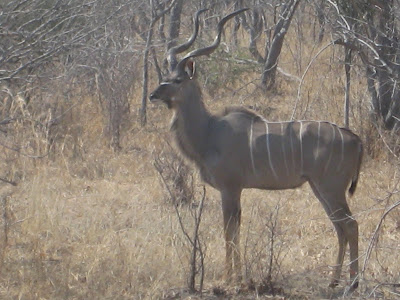Today we went out to survey giraffe skin disease in Ruaha. The group split in thirds to cover more area, and we each went to a separate part of the park. My group made a large loop north of park headquarters, doubling back through higher altitude miombo forest down to riverine terrain, although there was little water to be found in the riverbanks. We saw lots of different groups of giraffes, mostly at or near the water sources. Using binoculars, we assessed the prevalence and severity of skin lesions on the giraffes we could see. Most of the lesions were on the caudal aspect of the forelimb carpus joint, so hard to see in high grass or bushes, or if the giraffes were standing facing us. This definitely limited the numbers we could asses--we were only able to asses about half the giraffes we saw. Out of these, though, over 80% were affected in some way with the skin lesions. I'm sure this number is artificially high, though, since it was much easier to pick out lesions than to definitively say that a giraffe was free of the disease. So the actual prevalence in the population would likely be much lower.
While surveying, we saw lots of other wildlife, although nothing that we hadn't seen before. We had a lot of really cool close encounters with elephants along the road, and got to see one large male eating from a super tall tree, and a few mock charges at the car as mothers protected their young. The weather was beautiful--not a cloud in the sky, and warmed up to probably over 80º F in the afternoon.
We had some down time to shower and relax--and wait for one of the Land Rovers to go rescue the people from another one that broke down mid-journey--before meeting up again to discuss the results of our various groups' surveys. In my opinion, the data were not very rigorous, judging by how subjective our assessments were, and how prone to error especially since none of us as any experience. I think it's unrealistic to use the data we collected as anything more than anecdotal or incidental, or as background to inform a more objective study of the prevalence of this disease and its effects on the giraffe population. With such a high prevalence level, and specially because the disease progresses during the rainy season to become much worse, this seems to have potential to wreak havoc on the giraffes here in Ruaha.
Our nighttime lecture was moved to tomorrow morning, so tonight we have some time in the evening to sit around the campfire and talk about what we're going to do when we hear the lions coming through again tonight like we did last night.
Subscribe to:
Post Comments (Atom)






No comments:
Post a Comment